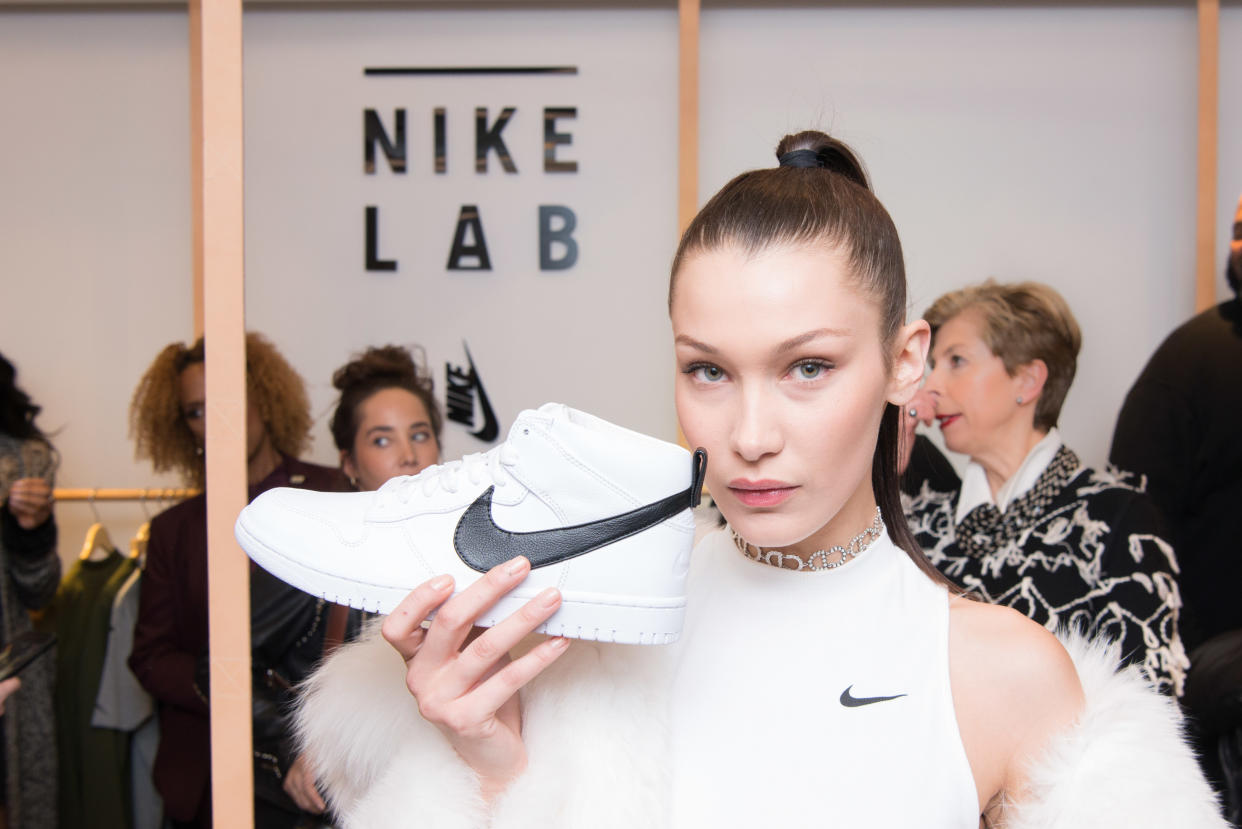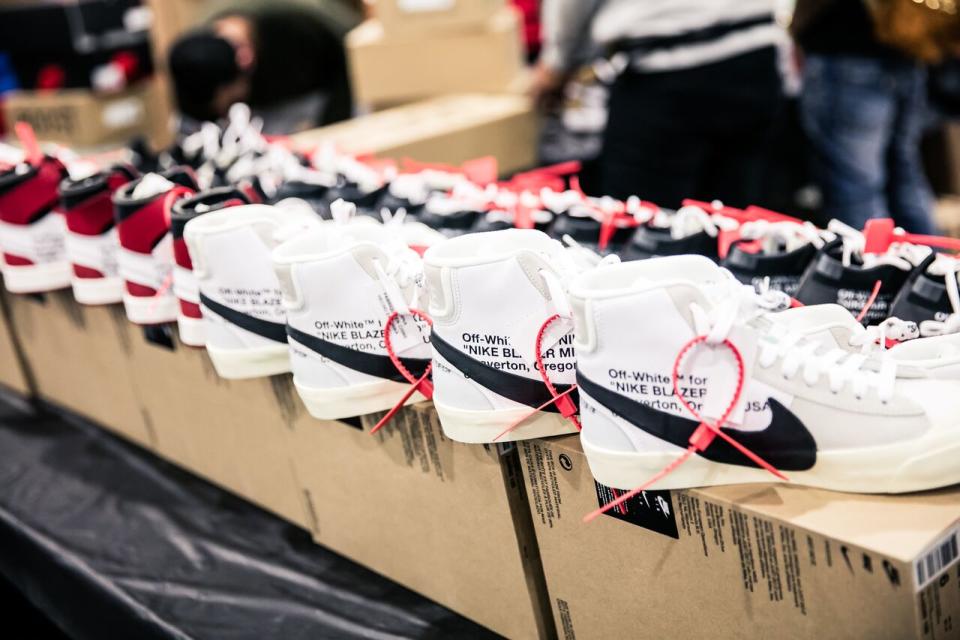Why the $17.5 billion sneaker market might want to start paying attention to women

On a Saturday afternoon in December, two young women walked toward New York City’s Javits Convention Center, one wearing Yeezy Boost 350 V2 sneakers and the other a pair of blue and white high-top Nike Air Force 1’s. Both wore Supreme backpacks and hats.
The two were headed toward Sneaker Con, the annual sneaker expo, which, like a Comic Con or DragCon, is hosted at the sprawling 840,000-square-foot convention space. Sneaker Con NYC is the flagship show of all its incarnations, attracting the greatest number of attendees and the most valuable merchandise for an event that also hits major cities like London, Berlin, and Las Vegas. This year, 19,000 people attended the two-day event, where more than $1 billion worth of sneakers were up for grabs.
But the two women represented a select few among the thousands of attendees — mostly young men and teenage boys — immersed in sneaker culture, which largely caters to men’s tastes.
At Sneaker Con, 500 vendors and independent sellers come together to trade, buy, and sell the most popular and often rarest sneakers and merchandise on the market. This year, they included Virgil Abloh’s Off-White Nike collaborative shoes, “The Ten” collection; Kanye West’s Yeezy; and Jordan Retro 4’s. This year’s expo also brought with it some YouTube vloggers with millions of followers across platforms, including 17-year-old Giancarlo Purch, whose online moniker is Blazendary, and Qias Omar from the Qrew crew. Both Internet stars had fans lined up waiting for photos and autographs.

It’s all part of “the culture,” a common refrain for all that embodies the sneakerhead lifestyle. A “hype beast” — a designation (or epithet, depending on who’s using it) for someone deeply embedded in sneaker and streetwear culture — eagerly anticipates “drops,” or product releases, often limited, that create online frenzies and a secondhand market where it’s not uncommon for a pair of sneakers to resell for $10,000.
Sneaker culture permeated the mainstream in 2017, when luxury players like Balenciaga, Gucci, and Louis Vuitton, among others, sold their own sneakers and streetwear, sometimes working with stalwarts like Supreme (in Louis Vuitton’s case), dropping products online and in limited quantities to propagate the pandemonium. There are sneaker “stock” exchanges, bots devoted to hacking the online drop system, and websites like High Snobiety dedicated to enumerating all things streetwear.

Still, despite the mainstream frenzy around the culture, women, as consumers, are largely neglected.
“I honestly feel that women play just as important a role [in sneaker culture] as men,” Christine Su, the owner of Heir PR and a Sneaker Con attendee, tells Yahoo Lifestyle on the floor of the Javits Center. Before starting her own communications firm, Su worked at Complex magazine, Adidas, and Nike owned-Converse. “There’s a huge appetite from females for sneakers. For us, we want our own silhouettes, our own styles. We don’t want you to just ‘shrink it and pink it,’” she said, referring to the industry parlance for designing styles for women. “We want the same things the guys have. We want our own styles, our own things, and we want you to collaborate with other girls doing amazing things.”
Su says that while brands like Nike and Puma have launched marketing campaigns that target young women (Bella Hadid’s Nike Cortez campaign this summer and the Rihanna Fenty Puma line, for example), companies need to change from within, hiring more diverse employees, including women.
“Because I worked at both brands, I know there needs to be more of a shift to bringing women in internally to corporate companies. It’s a boys’ club; they try to bring in females and diversity, but they’re still lacking in that. From the outside, it might appear like one thing, but on the inside, there still needs to be a call to action to get more females involved.”
It’s not only the clothing companies that require a culture shift, but also the media surrounding sneaker culture. Take the popular video series Sneaker Shopping, produced by Complex magazine. The series’s host, Joe La Puma, interviews guests including athletes and musicians in sneaker stores around the country about their favorite shoes. The series has more than 80 videos, six of which feature women including Amber Rose, Blac Chyna, and Bella Hadid, whose segment promoting the model’s Nike campaign went viral after Hadid’s vernacular relied heavily on slang uncharacteristic of a Dutch-Palestinian woman born into massive wealth in Los Angeles.
But whenever La Puma asks questions of a woman on the series, he seems to regard women as outsiders to the sneaker world. “So, I want to get a female’s perspective on the sneaker game,” La Puma asks frequently. When he’s not pandering to the women guests (“OK, you actually know your stuff,” La Puma told Amber Rose), he’s asking them whether they like pink and purple styles. “Some girls like overly girly colorways,” La Puma prompted during his segment with the actress Karrueche Tran. “I’m not into pinks and purples and really girly colors,” she responded. “No, no, no.”
Women currently represent 27 percent of the $17.5 billion U.S. sneaker market, a number expected to continue to grow in 2018, according to NPD Group’s sports industry analyst Matt Powell, an authority on the subject. Powell says the industry underserves women because it largely fails to create styles and sizes exclusive to women, whose feet are typically narrower than men’s. “In many cases, brands force women to buy boys’ shoes like for Jordans or LeBrons. You’re not going to see a lot of women-specific shoes, so when the sales account for 27 percent of the market, it might be because the market only offers 10 percent — and I’d be surprised at that — women-specific styles.”

Figures like that manifest with a walk through Sneaker Con NYC. Within the expo, there was only one booth in the 840,000-square-foot space that focused on women’s products: the Chicks with Kicks, a trio of sisters who inherited their father’s collection of 6,000-plus sneakers dating back to the 1980s, and who now sell their own merchandise. The merch — shirts that rip off the popular Anti Social Social Club logo with their own “Anti-Hypebeast Hypebeast”-stamped items — was laid out on a table in front of a backdrop with the trio’s Powerpuff Girls-styled logo.
Next year, the sisters are opening a sneaker store in South Florida, where they intend to start selling their collection, along with their T-shirts and dad caps. “We thought it was a way for girls who come [to Sneaker Con], who maybe don’t want to go to a booth filled with guys, to come to a women’s booth,” says 18-year-old Dakota Peters, one-third of the Chicks with Kicks. “They’ll come by the booth and tell us, ‘We love the sneaker community but feel intimidated by the other booths.'”
Ariana Peters, 24, adds, “I think more girls should get involved in the sneaker game, even though it’s a male-dominated thing. Everything in the world is. We’re just ready to take over.”
Nearby, Mina Wardak, part of the popular YouTube “crew” QrewTV, stood beside a meet-and-greet line of fans waiting to talk to her fiancé and the star of the YouTube channel Qias Omar. She wore a pair of Chanel by Pharrell Williams Adidas sneakers (one of only 500 made), which were named the most valuable sneakers of 2017 and have an average resell price of $11,791. Omar surprised Wardak with the sneakers that morning to celebrate their two-year anniversary (Wardak gifted Omar a pair of yet-unreleased black Gucci sneakers in return). By the time Sneaker Con began that day, Omar had already posted a video of the moment to his YouTube channel, which promptly received more than a quarter million views.
Wardak attended Sneaker Con to support Omar, the self-referential “biggest hypebeast on YouTube.” When asked how women fit into sneaker culture, Wardak says, “I think it’s hard to find a lot of women sneakerheads. It’s kind of hard because I have big feet, so for me it’s better, like, when there’s a release for something I want, I’m able to get it in the men’s sizes; but a lot of girls have smaller feet, so it sucks they miss out on releases. I’ve missed out on some of the releases.”
While brands have work to do to catch up with women’s preferences (note: not pink), the women’s sneakerhead movement is burgeoning. The website HypeBae — to complement the site HypeBeast — launched a new series called “Baes with Kicks,” which profiles women sneakerheads and provides guides to the best sneaker shops for women.
Still, that’s only worth as much as brands actually stocking inventory made especially for women.
Tameika Hawkins, a 42-year-old woman who drove to New York City from North Carolina specifically for Sneaker Con, browsed the booths, looking for shoes to add to her 200-plus sneaker collection. Donning a pair of sea-foam-green Chinese New Year Jordan 13’s, she lamented the new sneakers that she already knows she won’t be able to buy.
“I get a little frustrated, especially for the sneakers I really want, like the ones coming out next month, the ‘Gatorade’ Air Jordan 6. I really, really want those, but they’re not going to come out in my size.”
Read more from Yahoo Style + Beauty:
Models wear ‘not for sale’ tags to protest Libya slave trade crisis in powerful photo shoot
Christian Bale is excited for white dudes to stop running things in America
Actresses may wear black to the Golden Globes to protest sexual harassment. Is that ‘slacktivism’?
Follow us on Instagram, Facebook, and Pinterest for nonstop inspiration delivered fresh to your feed, every day. For Twitter updates, follow @YahooStyle and @YahooBeauty.


